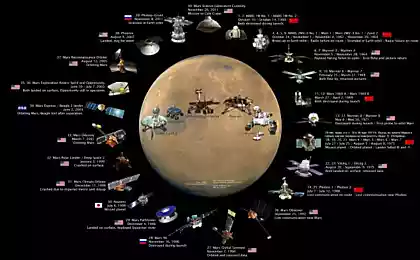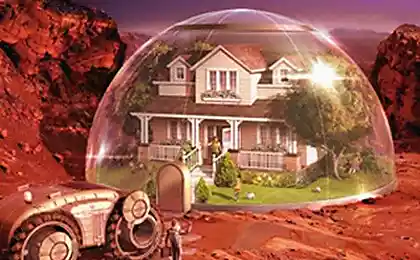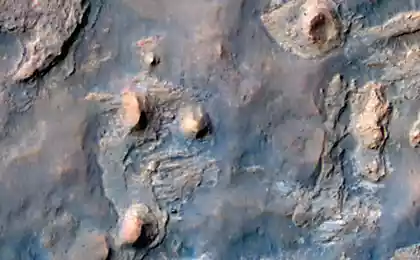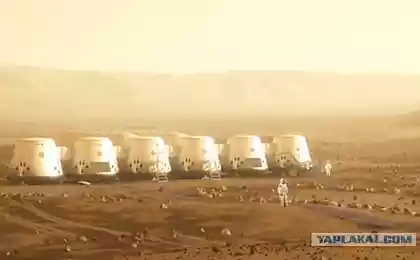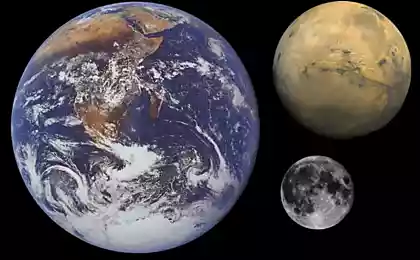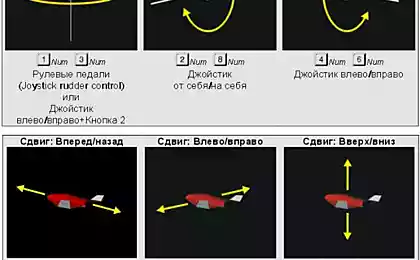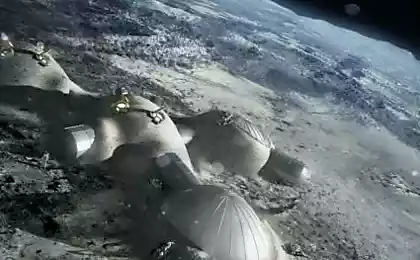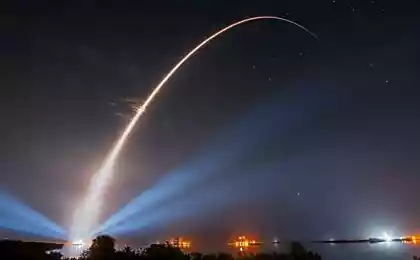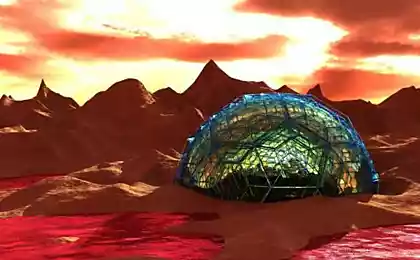1490
Operation "Mars Reconnaissance Orbiter" orbit planets
High definition camera (HiRISE) received the first cartographic images of the Martian surface from a height of 280 km, with a resolution of 25 cm / pixel! Take a look at these pictures.
Layered sediments in the canyon Hebe. (NASA / JPL / University of Arizona)
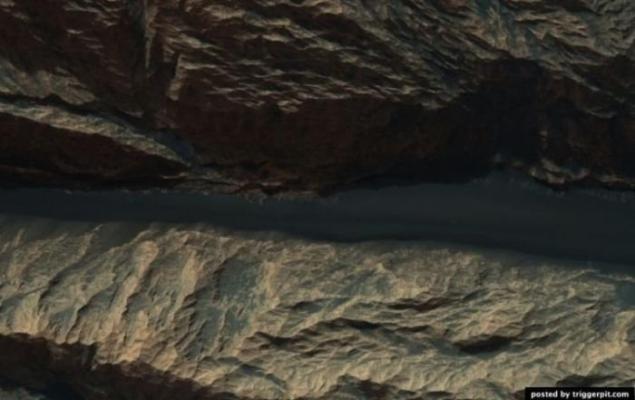
Bumps in the wall of the crater Gus. (NASA / JPL / University of Arizona)

Russell Crater Dunes. (NASA / JPL / University of Arizona)
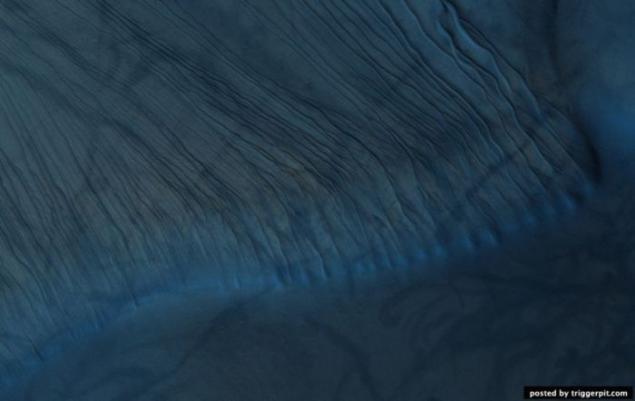
Geysers Manhattan. (NASA / JPL / University of Arizona)

The surface of Mars is covered with dry ice. You had ever play with dry ice (of course in leather gloves!)? Then you have probably noticed that the dry ice from a solid directly into a gas passes, unlike ordinary ice, which is heated, turns into water. On Mars ice caps are composed of dry ice (carbon dioxide). When in the spring on the ice fall sunshine, it goes into a gaseous state, which causes erosion surface. Erosion creates whimsical spider form. In this picture shows the channels that have arisen as a result of erosion and light-filled with ice, which comes in contrast to the muted red of the surrounding surface. In summer, the ice dissolves in the atmosphere, and instead will only channels like ghostly spiders carved on the surface. This kind of erosion is typical only for Mars is not possible under natural conditions in the world, because our climate is too warm. Lyricist: Candy Hansen (21 March 2011) (NASA / JPL / University of Arizona)

The layered mineral deposits located on the southern tip of the crater in the middle latitudes. The bright layered deposits are visible in the center of the image; they appear along the edges of the mesas, situated on a hill. Such deposits can be found in many places on Mars, including the craters and canyons near the equator. He could have been formed as a result of sedimentary processes by wind and / whether the water. Around the mesa visible dunes or folded education. The folded structure is the result of differential erosion, when some materials can be eroded more easily than others. Perhaps this area was once covered in soft sediments, which have now disappeared due to erosion. Lyricist: Kelly Kolb (April 15, 2009) (NASA / JPL / University of Arizona)
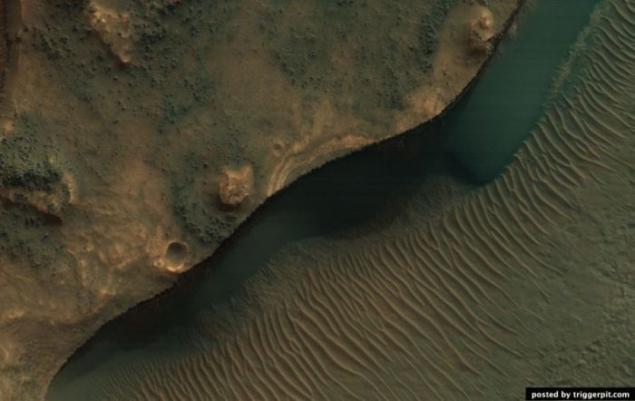
Bedrock, projecting on the walls and central peaks of the crater. (NASA / JPL / University of Arizona)
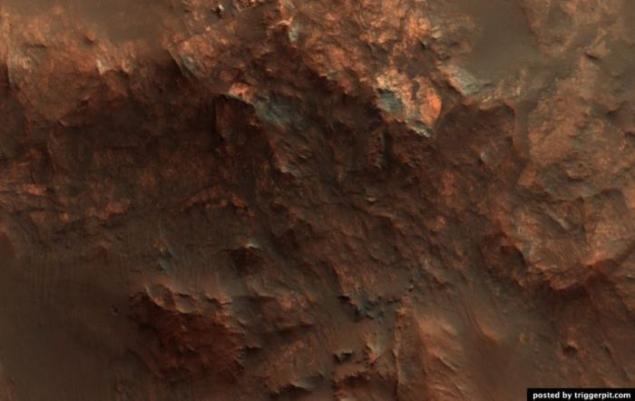
The solid structure of the salt mountain in a canyon Ganges. (NASA / JPL / University of Arizona)
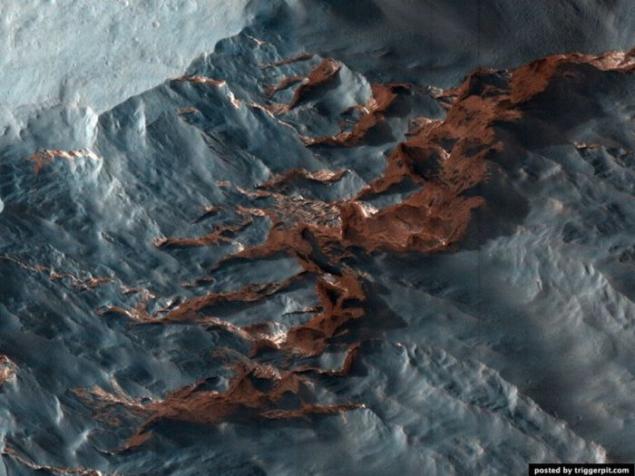
Someone cut a piece of the planet! (NASA / JPL / University of Arizona)

Sand mounds, formed as a result of spring dust storms in the North Pole. (NASA / JPL / University of Arizona)

Crater with a central hill with a diameter of 12 kilometers. (NASA / JPL / University of Arizona)
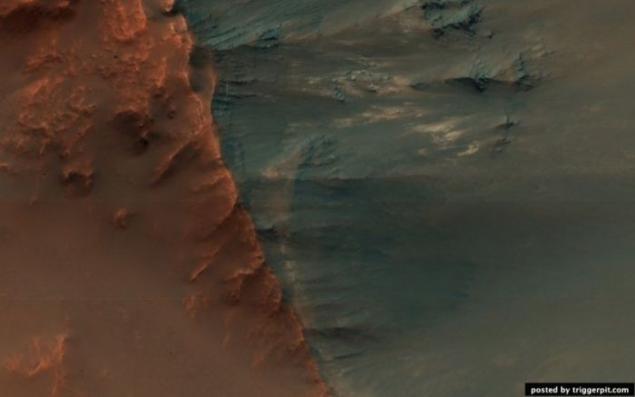
Cerberus Fossae system faults on the surface of Mars. (NASA / JPL / University of Arizona)
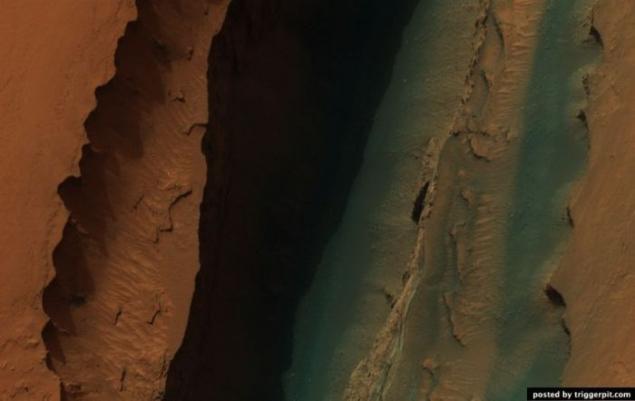
Purple Proctor Crater Dunes. (NASA / JPL / University of Arizona)
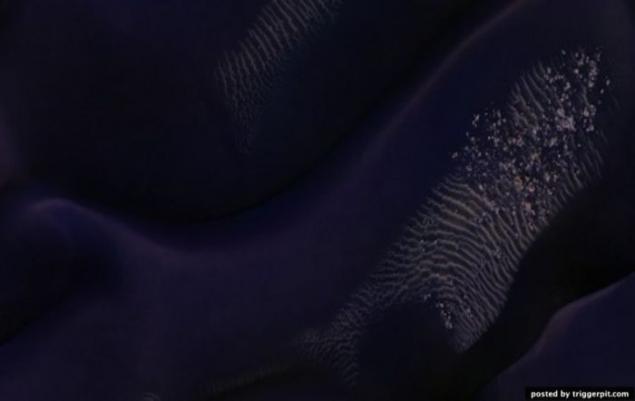
Outcrops of light wood on the walls of the mesa located in the Land of the Sirens. (NASA / JPL / University of Arizona)
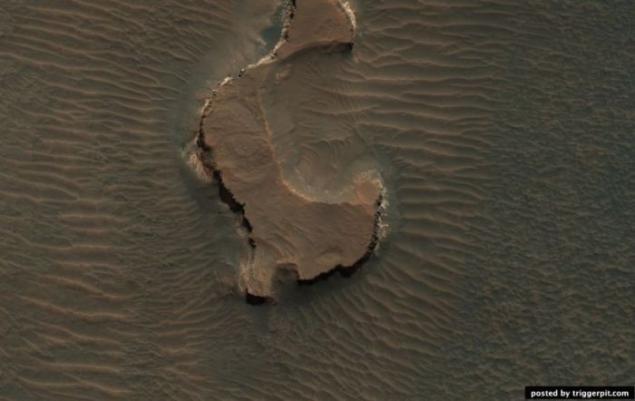
Spring changes in the Ithaca area. (NASA / JPL / University of Arizona)
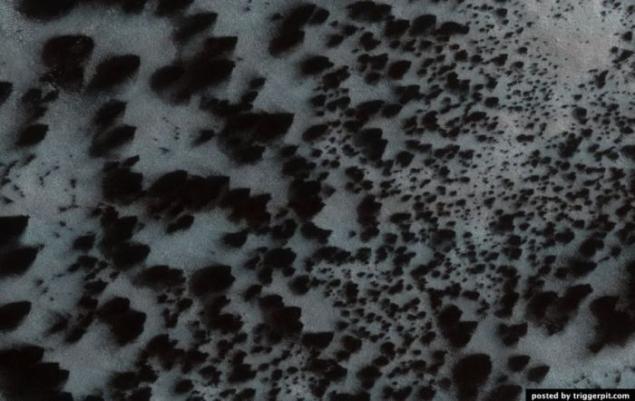
Russell Crater Dunes. Photos taken in the crater Russell studied repeatedly in order to monitor changes in the landscape. In this picture shows some dark education, which probably arose under the influence of multiple dust storms, which claimed the bright dust from the surface of the dunes. Narrow channels continue to be formed on the surfaces of steep sand dunes. Groove at the end of the channels can be a place where accumulated blocks of dry ice before moving on to a gaseous state. Lyricist: Ken Herkenhoff (9 March 2011) (NASA / JPL / University of Arizona)
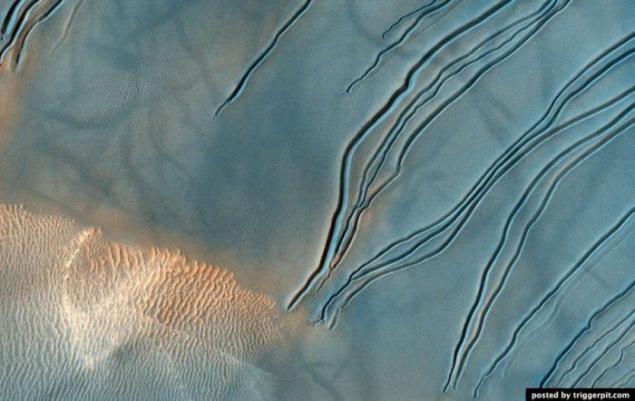
Runners on the walls of the crater at outcrop. (NASA / JPL / University of Arizona)
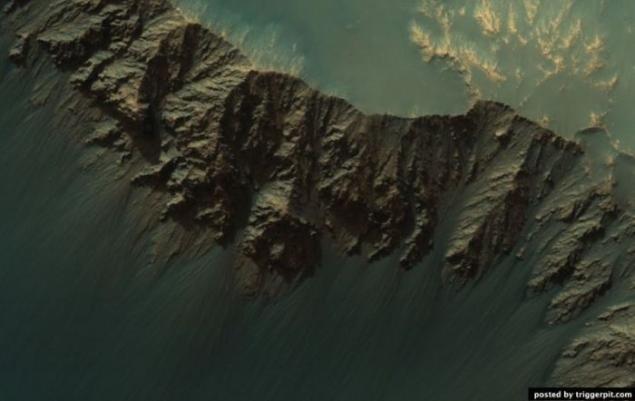
Runners on the walls of the crater at outcrop. (NASA / JPL / University of Arizona)

Areas where possible contain a lot of olivine. (NASA / JPL / University of Arizona)
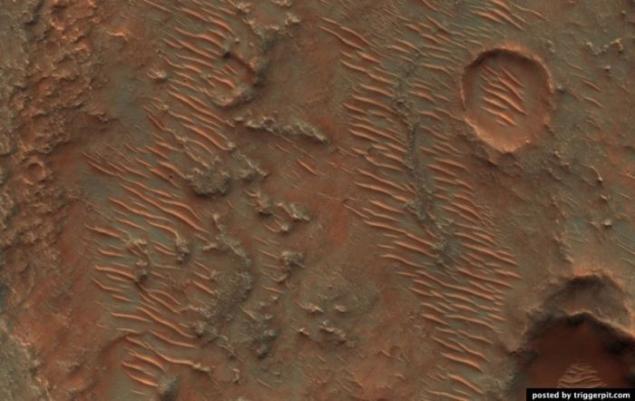
Ravines between dunes on the crater floor Kaiser. (NASA / JPL / University of Arizona)
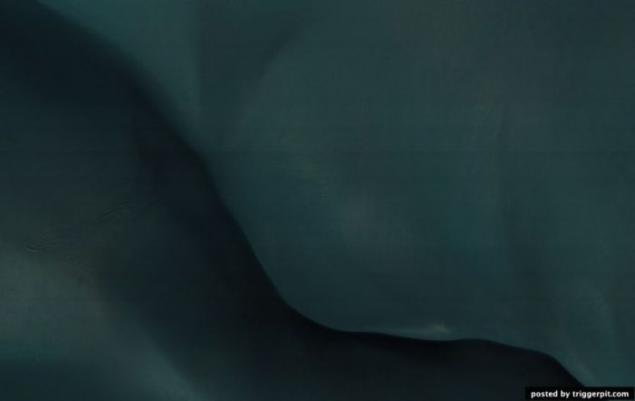
Mort Valley. (NASA / JPL / University of Arizona)
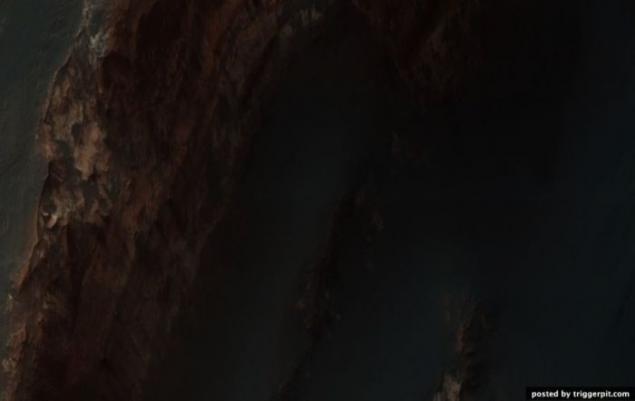
The sediments at the bottom of the canyon labyrinth of the night. (NASA / JPL / University of Arizona)

Holden Crater. (NASA / JPL / University of Arizona)
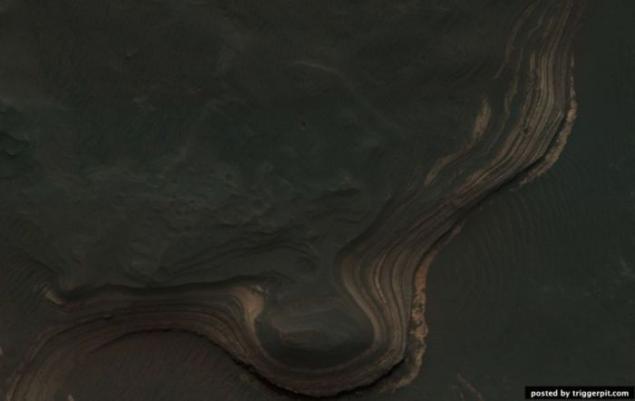
Crater St. Mary (Santa Maria Crater). The device made HiRISE color image crater St. Mary which is visible AGV Opportunity, which is stuck in yuzhnovostochnogo edge of the crater. AGV collected data on this relatively new crater with a diameter of 90 meters, in order to determine what factors influenced his appearance. Pay attention to the surrounding blocks and rays formations. Spectral analysis reveals the presence CRISM hydrosulfate in this area. Debris AGV located at a distance of 6 kilometers from the edge of the crater Endeavour Crater, which are the basic materials hydrogen sulfates and phyllosilicates. (NASA / JPL / University of Arizona)
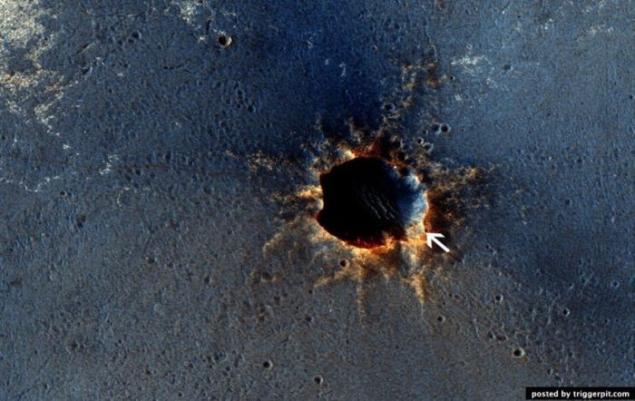
Central hill large, well-preserved crater. (NASA / JPL / University of Arizona)
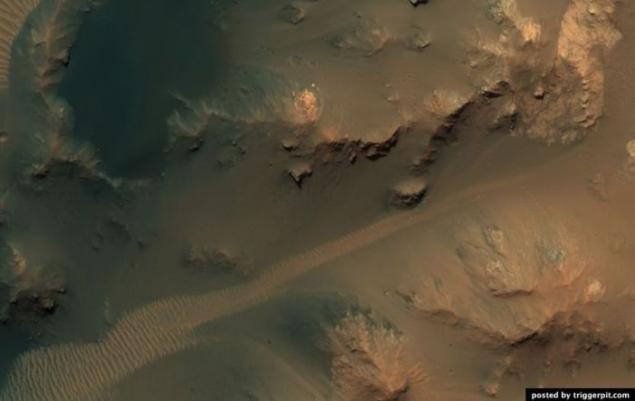
Russell Crater Dunes. (NASA / JPL / University of Arizona)
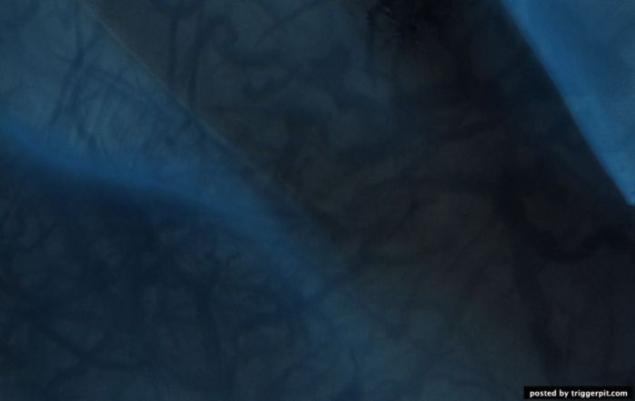
Layered deposits in the canyon Hebe. (NASA / JPL / University of Arizona)
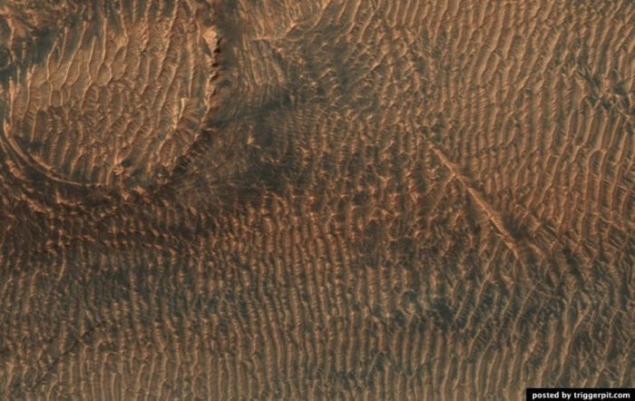
District yardang Eumenides Dorsum. (NASA / JPL / University of Arizona)
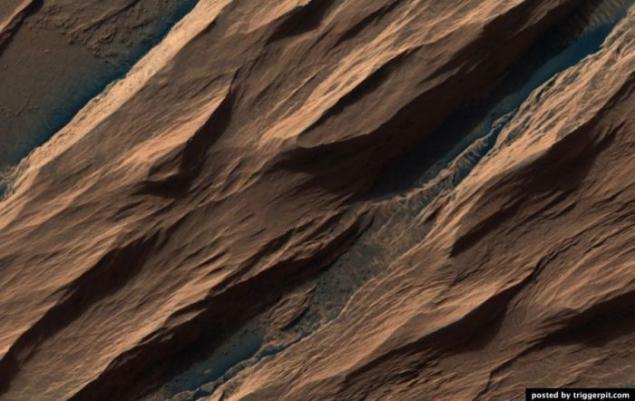
Movement of sand in the Gusev Crater, located near the Columbia Hills. (NASA / JPL / University of Arizona)

North ridge of Hellas Planitia, which is probably rich in olivine. (NASA / JPL / University of Arizona)
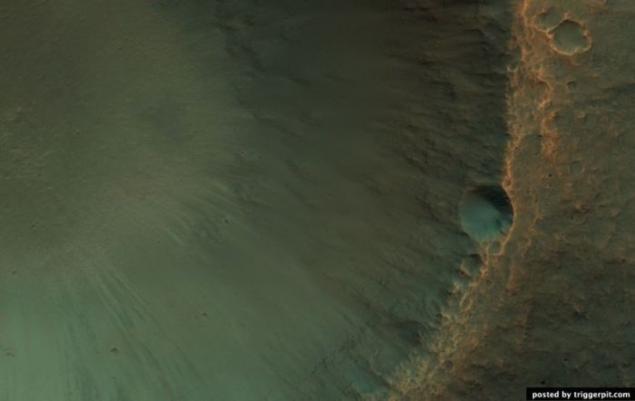
Seasonal changes in the area of the South Pole covered with cracks and potholes. (NASA / JPL / University of Arizona)

The remains of the southern polar caps in spring. (NASA / JPL / University of Arizona)

Frozen troughs and potholes on the pole. (NASA / JPL / University of Arizona)
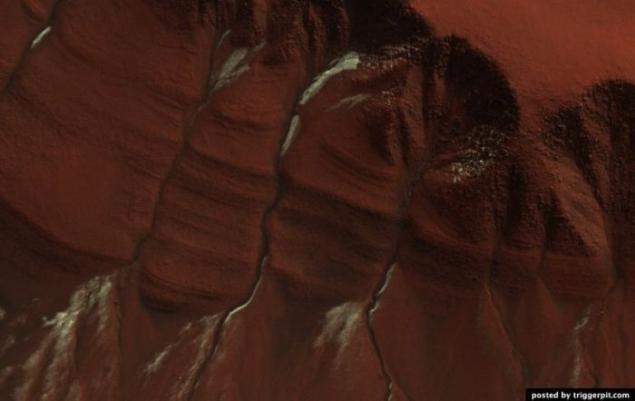
Deposits (probably of volcanic origin) in the Maze at night. (NASA / JPL / University of Arizona)
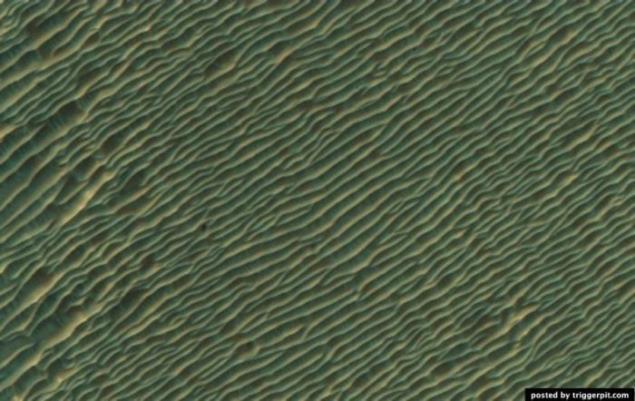
The layered outcrops in the crater wall, located at the North Pole. (NASA / JPL / University of Arizona)
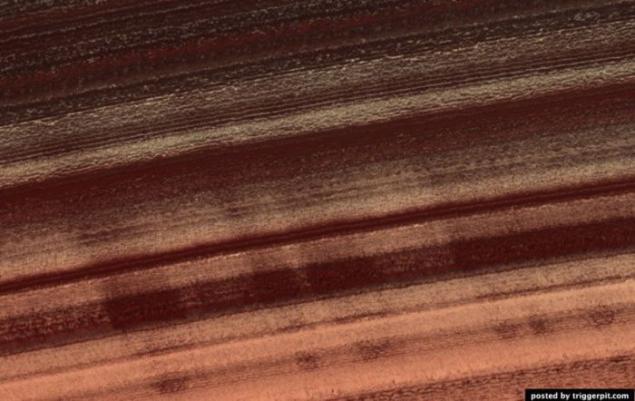
A single spider education. This formation is a channel carved into the surface, which were formed under the influence of evaporation of carbon dioxide. Channels are organized radially widened and deepened as they approach the center. On Earth, similar processes occurs. (NASA / JPL / University of Arizona)
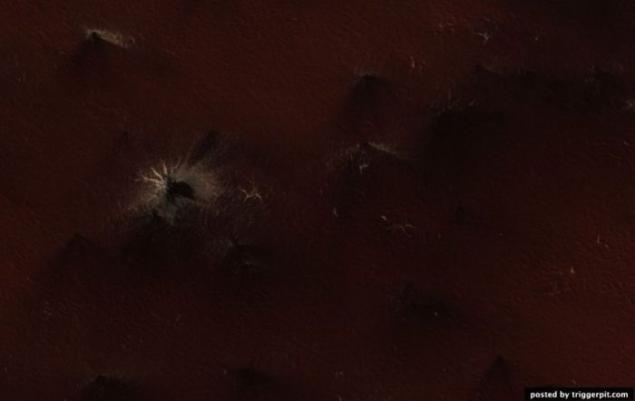
The relief of the Athabasca Valley. (NASA / JPL / University of Arizona)
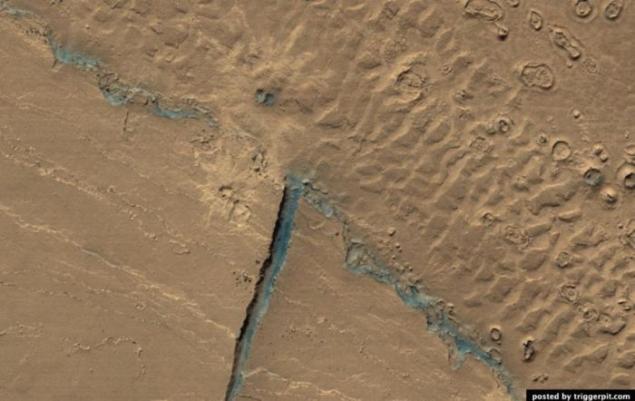
Cones craters plain Utopia (Utopia Planitia). Utopia Planitia (Utopia Planitia) - giant lowland, located in the eastern part of the northern hemisphere of Mars, and is adjacent to the northern Great Plains. Craters in the area of volcanic origin, as evidenced by their shape. Craters hardly prone to erosion. Cone-shaped hills or craters like formations depicted in this picture, are quite common in the northern latitudes of Mars. (NASA / JPL / University of Arizona)
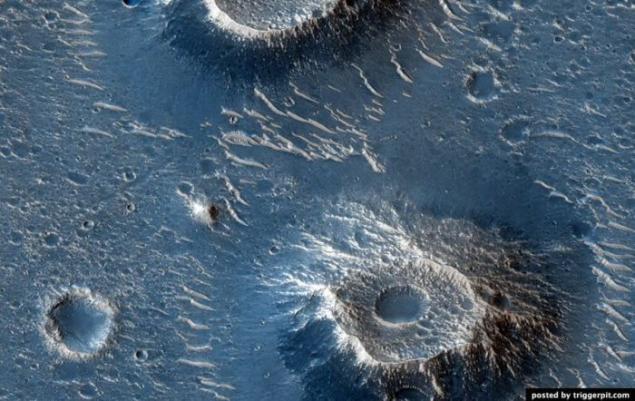
The polar sand dunes. (NASA / JPL / University of Arizona)
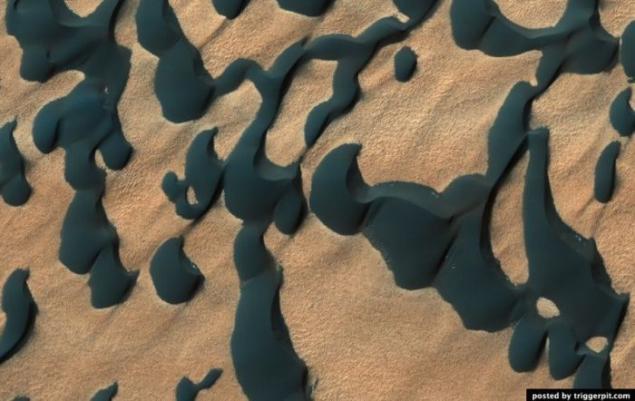
The interior of the crater Tooting. (NASA / JPL / University of Arizona)

Trees on Mars !!! In this photo we see something that is strikingly similar to the trees growing among the Martian dunes. But these "trees" - an optical illusion. In fact, this dark deposits on the lee side of the dunes. They came as a result of the evaporation of carbon dioxide, "dry ice". The evaporation process starts at the bottom of the ice formation as a result of this process, a pair of gas discharged through the pores on the surface and simultaneously render dark deposits that remain lying napoverhnosti. This picture was taken with the device HiRISE, installed aboard the reconnaissance satellite NASA Orbiter in April 2008. (NASA / JPL / University of Arizona)
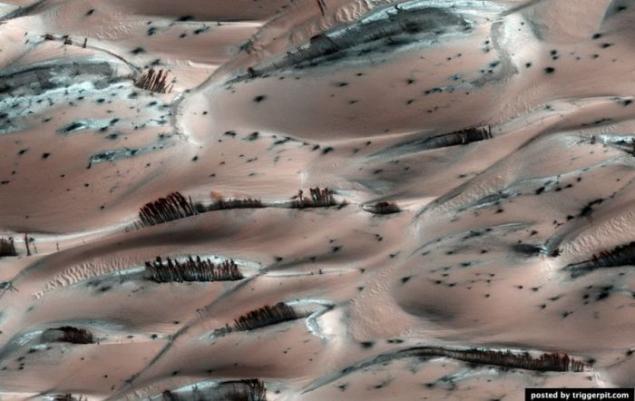
Victoria Crater. The picture can be seen on the wall of the crater deposits. The bottom of the crater covered with sand dunes. On the left are fragments robokara NASAOpportunity. The picture was taken apparatus HiRISE, installed aboard the reconnaissance satellite NASA Orbiter, in July 2009. (NASA / JPL-Caltech / University of Arizona)
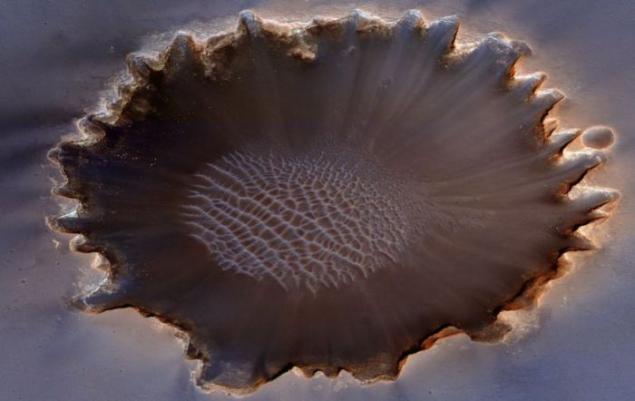
Linear dunes. These strips - linear sand dunes on the crater floor near Noachis Terra. Dark areas - this yourself dunes and bright - the gaps between the dunes. Photo taken December 28, 2009 the astronomical high resolution camera HiRISE (High-Resolution Imaging Science Experiment), installed aboard the reconnaissance satellite NASA Orbiter. (NASA / JPL / University of Arizona)
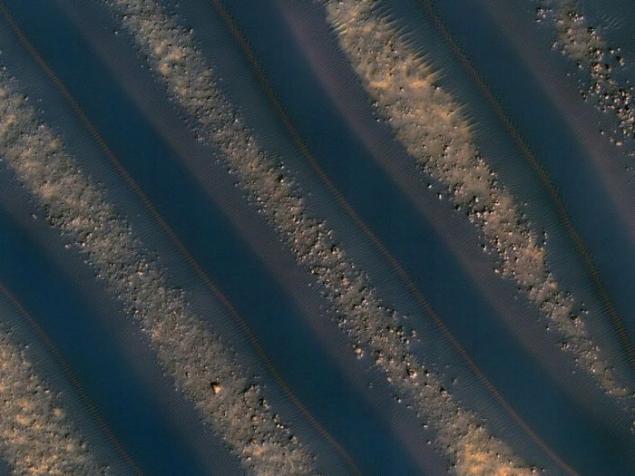
via source
Layered sediments in the canyon Hebe. (NASA / JPL / University of Arizona)

Bumps in the wall of the crater Gus. (NASA / JPL / University of Arizona)

Russell Crater Dunes. (NASA / JPL / University of Arizona)

Geysers Manhattan. (NASA / JPL / University of Arizona)

The surface of Mars is covered with dry ice. You had ever play with dry ice (of course in leather gloves!)? Then you have probably noticed that the dry ice from a solid directly into a gas passes, unlike ordinary ice, which is heated, turns into water. On Mars ice caps are composed of dry ice (carbon dioxide). When in the spring on the ice fall sunshine, it goes into a gaseous state, which causes erosion surface. Erosion creates whimsical spider form. In this picture shows the channels that have arisen as a result of erosion and light-filled with ice, which comes in contrast to the muted red of the surrounding surface. In summer, the ice dissolves in the atmosphere, and instead will only channels like ghostly spiders carved on the surface. This kind of erosion is typical only for Mars is not possible under natural conditions in the world, because our climate is too warm. Lyricist: Candy Hansen (21 March 2011) (NASA / JPL / University of Arizona)

The layered mineral deposits located on the southern tip of the crater in the middle latitudes. The bright layered deposits are visible in the center of the image; they appear along the edges of the mesas, situated on a hill. Such deposits can be found in many places on Mars, including the craters and canyons near the equator. He could have been formed as a result of sedimentary processes by wind and / whether the water. Around the mesa visible dunes or folded education. The folded structure is the result of differential erosion, when some materials can be eroded more easily than others. Perhaps this area was once covered in soft sediments, which have now disappeared due to erosion. Lyricist: Kelly Kolb (April 15, 2009) (NASA / JPL / University of Arizona)

Bedrock, projecting on the walls and central peaks of the crater. (NASA / JPL / University of Arizona)

The solid structure of the salt mountain in a canyon Ganges. (NASA / JPL / University of Arizona)

Someone cut a piece of the planet! (NASA / JPL / University of Arizona)

Sand mounds, formed as a result of spring dust storms in the North Pole. (NASA / JPL / University of Arizona)

Crater with a central hill with a diameter of 12 kilometers. (NASA / JPL / University of Arizona)

Cerberus Fossae system faults on the surface of Mars. (NASA / JPL / University of Arizona)

Purple Proctor Crater Dunes. (NASA / JPL / University of Arizona)

Outcrops of light wood on the walls of the mesa located in the Land of the Sirens. (NASA / JPL / University of Arizona)

Spring changes in the Ithaca area. (NASA / JPL / University of Arizona)

Russell Crater Dunes. Photos taken in the crater Russell studied repeatedly in order to monitor changes in the landscape. In this picture shows some dark education, which probably arose under the influence of multiple dust storms, which claimed the bright dust from the surface of the dunes. Narrow channels continue to be formed on the surfaces of steep sand dunes. Groove at the end of the channels can be a place where accumulated blocks of dry ice before moving on to a gaseous state. Lyricist: Ken Herkenhoff (9 March 2011) (NASA / JPL / University of Arizona)

Runners on the walls of the crater at outcrop. (NASA / JPL / University of Arizona)

Runners on the walls of the crater at outcrop. (NASA / JPL / University of Arizona)

Areas where possible contain a lot of olivine. (NASA / JPL / University of Arizona)

Ravines between dunes on the crater floor Kaiser. (NASA / JPL / University of Arizona)

Mort Valley. (NASA / JPL / University of Arizona)

The sediments at the bottom of the canyon labyrinth of the night. (NASA / JPL / University of Arizona)

Holden Crater. (NASA / JPL / University of Arizona)

Crater St. Mary (Santa Maria Crater). The device made HiRISE color image crater St. Mary which is visible AGV Opportunity, which is stuck in yuzhnovostochnogo edge of the crater. AGV collected data on this relatively new crater with a diameter of 90 meters, in order to determine what factors influenced his appearance. Pay attention to the surrounding blocks and rays formations. Spectral analysis reveals the presence CRISM hydrosulfate in this area. Debris AGV located at a distance of 6 kilometers from the edge of the crater Endeavour Crater, which are the basic materials hydrogen sulfates and phyllosilicates. (NASA / JPL / University of Arizona)

Central hill large, well-preserved crater. (NASA / JPL / University of Arizona)

Russell Crater Dunes. (NASA / JPL / University of Arizona)

Layered deposits in the canyon Hebe. (NASA / JPL / University of Arizona)

District yardang Eumenides Dorsum. (NASA / JPL / University of Arizona)

Movement of sand in the Gusev Crater, located near the Columbia Hills. (NASA / JPL / University of Arizona)

North ridge of Hellas Planitia, which is probably rich in olivine. (NASA / JPL / University of Arizona)

Seasonal changes in the area of the South Pole covered with cracks and potholes. (NASA / JPL / University of Arizona)

The remains of the southern polar caps in spring. (NASA / JPL / University of Arizona)

Frozen troughs and potholes on the pole. (NASA / JPL / University of Arizona)

Deposits (probably of volcanic origin) in the Maze at night. (NASA / JPL / University of Arizona)

The layered outcrops in the crater wall, located at the North Pole. (NASA / JPL / University of Arizona)

A single spider education. This formation is a channel carved into the surface, which were formed under the influence of evaporation of carbon dioxide. Channels are organized radially widened and deepened as they approach the center. On Earth, similar processes occurs. (NASA / JPL / University of Arizona)

The relief of the Athabasca Valley. (NASA / JPL / University of Arizona)

Cones craters plain Utopia (Utopia Planitia). Utopia Planitia (Utopia Planitia) - giant lowland, located in the eastern part of the northern hemisphere of Mars, and is adjacent to the northern Great Plains. Craters in the area of volcanic origin, as evidenced by their shape. Craters hardly prone to erosion. Cone-shaped hills or craters like formations depicted in this picture, are quite common in the northern latitudes of Mars. (NASA / JPL / University of Arizona)

The polar sand dunes. (NASA / JPL / University of Arizona)

The interior of the crater Tooting. (NASA / JPL / University of Arizona)

Trees on Mars !!! In this photo we see something that is strikingly similar to the trees growing among the Martian dunes. But these "trees" - an optical illusion. In fact, this dark deposits on the lee side of the dunes. They came as a result of the evaporation of carbon dioxide, "dry ice". The evaporation process starts at the bottom of the ice formation as a result of this process, a pair of gas discharged through the pores on the surface and simultaneously render dark deposits that remain lying napoverhnosti. This picture was taken with the device HiRISE, installed aboard the reconnaissance satellite NASA Orbiter in April 2008. (NASA / JPL / University of Arizona)

Victoria Crater. The picture can be seen on the wall of the crater deposits. The bottom of the crater covered with sand dunes. On the left are fragments robokara NASAOpportunity. The picture was taken apparatus HiRISE, installed aboard the reconnaissance satellite NASA Orbiter, in July 2009. (NASA / JPL-Caltech / University of Arizona)

Linear dunes. These strips - linear sand dunes on the crater floor near Noachis Terra. Dark areas - this yourself dunes and bright - the gaps between the dunes. Photo taken December 28, 2009 the astronomical high resolution camera HiRISE (High-Resolution Imaging Science Experiment), installed aboard the reconnaissance satellite NASA Orbiter. (NASA / JPL / University of Arizona)

via source
Family photos from the royal wedding
The house is from the movie "Home Alone" sold for $ 2, 4 million



